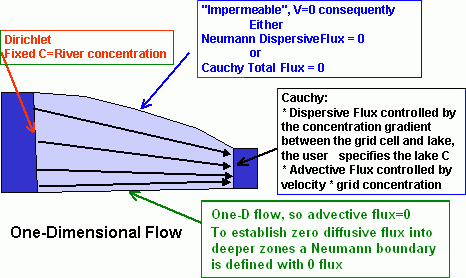BOUNDARY
CONDITIONS
MT3D includes:
specified concentration which may vary with time (Dirichlet Condition)
This is an infinite source or sink of mass. The rate of dispersive mass flux is controlled by the difference in concentration that is fixed and the concentration calculated in the adjacent node. The advective flux of mass across the boundary will be the product of the volumetric flux of water and the specified concentration.
fixed concentration gradient (fixed mass flux) across a boundary (Neumann Condition)
This defines the total flux of mass (both advective and dispersive). A no-flow boundary representing impermeable material is also a ZERO mass flux boundary because there is no advection or diffucion into the material. .
concentration dependent flux, or "combined" boundary (Cauchy Condition)
In this case both the concentration and the gradient are fixed, so that both the dispersive flux and the advective flux are individually defined. For impermeable boundaries, both the concentration and the gradient are zero. On inflow and outflow boundaries it is often assumed that advection dominates and can be simplified to a Neumann boundary.
EXAMPLE:

A common problem with transport boundary conditions is as follows: